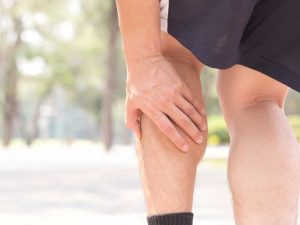
Damnit.
Two weekends ago, I was looking forward with much enthusiasm to the 25k Under Armor race at Copper Mountain. I’d completed a strong 20-mile run the previous weekend to cap off several weeks of hard training. I felt good and everything seemed in proper working order. So it was a surprise to me that I had to quit the race at mile two due to calf/Achilles pain.
The race started immediately with a long climb. It wasn’t terribly difficult, nothing for which I didn’t feel prepared. I was warmed up, had done some running-specific joint mobility drills, and I felt 100% ready to go. Temperatures were in the 60s and the sky was clear. Everything seemed in place for a good performance.
Noticeable calf pain started about 30-minutes into the race. It got worse with every step. Nothing snapped or gave way but the pain came on within several minutes and it quickly slowed my pace.
It’s not uncommon to have some odd ache or pain that fades out after a few minutes of activity. Not this time. Every step was more painful than the last. I stopped a few times, wiggled my foot, stretched the calf a little, tried to do anything at all to fix the issue and no luck. I was limping. One of the rules of pain to which I adhere is that if the pain is enough to alter my mechanics then it’s time to stop the activity.
This felt like an acute injury with pain brought on due to tissue damage. This pain wasn’t behaving like chronic pain. A light-speed PowerPoint presentation of possible outcomes flashed through my mind as several race-related questions materialized:
- Could I limp and hobble my way to the finish? I had about 13 miles and a lot of climbing left to do. At best it would take all day and I would limp painfully across the finish line. At worst I would have a seriously injured calf and wouldn’t be walking for weeks.
- What about my other races??? I have two other races, including the main event, the Grand Traverse on Sept 1. That’s the goal and the primary focus for this season. Anything that derails that race is to be avoided. This was a strong argument to quit.
- My ego sprang to life, the ego that identifies as a runner, a personal trainer, a very fit person, and someone who knows how to guard against injury. For good or ill, this ego needs others to know all these things, and see me as I want to see myself. To tell others that I quit a race could be a serious blow to Mr. Ego. This emotional, irrational dude pleaded to find a way to push on.
- Some 43-year-old part of my being chimed in. This individual seemed educated, experienced, emotionally balanced, and most importantly, honest. This voice evaluated the evidence and stated clearly, “Stop now! You’re done. Don’t be stupid. Not only is it the right decision, it’s the only decision.”
I quit the race, earning myself my first DNF (Did Not Finish) and limped down the mountain to the base. Boo hoo. It was a drag. It was frustrating. I was angry. All normal emotions in this circumstance. That said, I didn’t flush myself too far down the toilet of despair.
I’m not the first runner to quit a race. In fact, my bet is everyone who races in any serious way quits a race due to injury. No one can guard against every potential obstacle. I did the best I could to prepare but I’m not perfect. Further, it’s not like I did anything stupid. I didn’t get drunk the night before. I didn’t forget my shoes at home. I didn’t sabotage myself. (Continuing the race would definitely have been an act of self-sabotage.) Beating myself up ad nauseam would’ve been wasted energy, it wouldn’t have helped me heal faster, and it wouldn’t help me on my next race.
The good news is I made the right decision. I quit when it should have and I avoided a bad injury. I got some crucial information too: I must strengthen the left calf. I must be more thorough than I’ve been in the past. (Here’s a rundown of what I’ve written about the subject.) Here’s what I know:
- First and foremost I must let this injury heal. It would be a massive mistake to let it partially heal then go run and injure it again. This may take two weeks or more.
- My left lower leg strength (as measured by single-leg heel raise ability) is significantly weaker than my right.
- I’ve paid lip service in the past to my left lower leg. I must devote more time and effort to making it strong and keeping it strong.
- Once my calf heals and once I’m able to load it, I must worship at the altar of calf raises and other lower-leg exercises.
In an effort to maintain my conditioning I will replace running with cycling. Is cycling a good replacement for running? Not really. Considering various kinematic differences in turning a crank with my legs vs running (lack of eccentric loading in cycling, connective tissue contribution in running, joint angles, body position) cycling is noticeably different from running. Is there a better alternative? No.
